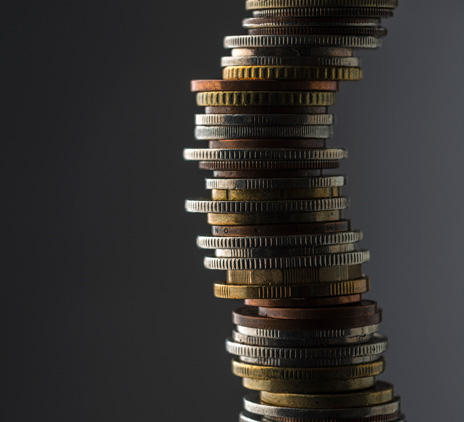-
Business valuations
We offer expert valuation advice in transactions, regulatory and administrative matters, and matters subject to dispute – valuing businesses, shares and intangible assets in a wide range of industries.
-
Capital markets
You need corporate finance specialists experienced in international capital markets on your side if you’re buying or selling financial securities.
-
Complex and international services
Our experience of multi-jurisdictional insolvencies coupled with our international reputation allows us to deliver the best possible outcome for all stakeholders.
-
Corporate insolvency
Our corporate investigation and recovery teams can help you manage insolvency situations and facilitate the best outcome.
-
Debt advisory
An optimal funding structure for your organisation presents unprecedented opportunities, but achieving this can be difficult without a trusted advisor.
-
Expert witness
Our expert witnesses analyse, interpret, summarise and present complex financial and business-related issues which are understandable and properly supported.
-
Financial models
A sound financial model will help you understand the impact of your decisions before you make them. Talk to us about our user-friendly models.
-
Forensic and investigation services
We provide investigative accounting and litigation support services for commercial, matrimonial, criminal, business valuation and insurance disputes.
-
Independent business review
Is your business viable? Will it remain viable in the future? A thorough independent business review can help your organisation answer these fundamental questions.
-
IT forensics
Effective ESI analysis is integral to the success of your business. Our IT forensics experts have the technical expertise to identify, preserve and interrogate electronic data.
-
Mergers and acquisitions
Grant Thornton provides strategic and execution support for mergers, acquisitions, sales and fundraising.
-
Raising finance
Raising finance - funders value partners who can deliver a robust financial model, a sound business strategy and rigorous planning. We can guide you through the challenges that these transactions can pose and help you build a foundation for long term success once the deal is done.
-
Relationship property services
Grant Thornton offers high quality independent advice on the many financial issues associated with relationship property from considering an individual financial issue to all aspects of a complex settlement.
-
Restructuring and turnaround
Grant Thornton’s restructuring and turnaround service capabilities include cash flow, liquidity management and forecasting; crisis and interim management; financial advisory services to companies and parties in transition and distress
-
Transaction advisory
Our depth of market knowledge will steer you through the transaction process. Grant Thornton’s dynamic teams offer range of financial, commercial and operational expertise.
-
Corporate tax
Grant Thornton can identify tax issues, risks and opportunities in your organisation and implement strategies to improve your bottom line.
-
Employment tax
Grant Thornton’s advisers can help you with PAYE (payroll tax), Kiwisaver, fringe benefits tax (FBT), student loans, global mobility services, international tax
-
Global mobility services
Our team can help expatriates and their employers deal with tax and employment matters both in New Zealand and overseas. With the correct planning advice, employee allowances and benefits may be structured to avoid double taxation and achieve tax savings.
-
GST
GST has the potential to become a minefield and can be expensive when it goes wrong. Our technical knowledge can help you minimise the negative impact of GST
-
International tax
International tax rules are undergoing their biggest change in a generation. Tax authorities around the world are increasingly vigilant, especially when it comes to global operations.
-
Research and Development
R&D tax incentives are often underused and misunderstood – is your business maximising opportunities for making claims?
-
Tax compliance
Our advisers help clients manage the critical issue of compliance across accountancy regulations, corporation law and tax. We also offer business and wealth advisory services, which means we can provide a seamless and tax-effective offering to our clients.
-
Transfer pricing
Tax authorities are demanding transparency in international arrangements. We businesses comply with regulations and use transfer pricing as a strategic planning tool.
-
Audit methodology
Our five step audit methodology offers a high quality service wherever you are in the world and includes planning, risk assessment, testing internal controls, substantive testing, and concluding and reporting
-
Audit technology
We apply our audit methodology with an integrated set of software tools known as the Voyager suite. Our technology has been developed to produce quality audits that are effective and efficient.
-
Financial reporting advisory
Our financial reporting advisers have the expertise to help you deal with the constantly evolving regulatory environment.
-
Business architecture
Our business architects help businesses with disruptive conditions, business expansion and competitive challenges; the deployment of your strategy is critical to success.
-
Cloud services
Our team is led by cloud business experts who tailor services to the needs of your organisation, from strategy and implementation to ongoing services assurance.
-
Internal audit
Our internal audits deliver independent assurance over key controls within your riskiest processes, proving what works and what doesn’t and recommending improvements.
-
IT advisory
Our hands on product experience, extensive functional knowledge and industry insights help clients solve complex IT and technology issues
-
IT privacy and security
IT privacy and security should support your business strategy. Our pragmatic approach focuses on reducing cyber security risks specific to your organisation
-
Organisational & cultural change
The key to sustainable and future growth is a unified organisation operating within a strong cultural context, where transparency and communication are the priority for Kaimahi, and where visible leadership means walking the talk – but where does that journey begin?
-
Payroll assurance
Our specialist payroll assurance team can conduct a review of your payroll system configuration and processes, and then help you and your team to implement any necessary recalculations.
-
PCI DSS
Our information security specialists are approved Qualified Security Assessors (QSAs) that have been qualified by the PCI Security Standards Council to independently assess merchants and service providers.
-
Process improvement
As your organisation grows in size and complexity, processes that were once enabling often become cumbersome and inefficient. To maintain growth, your business must remain flexible, agile and profitable
-
Procurement/supply chain
Procurement and supply chain inputs will often dominate your balance sheet and constantly evolve for organisations to remain competitive and meet changing customer requirements
-
Project assurance
Major programmes and projects expose you to significant financial and reputational risk throughout their life cycle. Don’t let these risks become a reality.
-
Risk management
We understand that growing companies need to establish robust internal controls, and use information technology to effectively mitigate risk.
-
Robotic process automation (RPA)
RPA is emerging as the most sophisticated form of automation used to help businesses become more agile and remain competitive in the face of today’s ongoing digital disruption.

Most Kiwi businesses are keen to reduce their carbon footprint – but the cost can be prohibitive. Unfortunately, the environmentally-friendly option isn’t always the cheapest.
It would be wonderful to see the Government step in and provide affordable financing for decarbonising the business sector, because we know this could work. There is the GIDI fund, but this is typically for large projects ($300,000 plus) being undertaken by major manufacturers and processors. There isn’t much available for the vast number of small and medium enterprises that make up the majority of Kiwi businesses.
Our major banks, though, have stepped up to provide some options. There are now sustainable lending products available to qualifying business borrowers of all sizes, with lower interest rates for projects that will improve your company’s sustainability and/or carbon footprint. These can be a win-win-win: they help your business cut emissions, support the bank’s own sustainability targets, and they improve national energy efficiency.
8 types of projects that are likely to qualify
The major banks all offer sustainability-linked loans and while their criteria differ, these are typically the eight types of projects that will meet the eligibility criteria at some or all of those lenders:
- Energy efficiency improvements. Investment in products and technology that will reduce energy consumption, such as switching from incandescent or halogen lighting to LEDs.
- Green buildings. This might include installing a digital energy management system or retrofitting a more efficient heating and ventilation system.
- Waste minimisation. Adhering to the principals of a circular economy by designing out waste at every stage of a product’s life cycle. This might mean using more recycled materials in packaging for instance, or making the product more recyclable at end of life. A loan could fund new equipment or materials, or go towards changing the manufacturing process.
- Process heat. Typically converting boilers from coal or natural gas to a cleaner energy source such as biomass or electricity.
- Renewable energy. Generating green energy; usually installing solar panels.
- Clean transportation. Switching from internal combustion engine vehicles to fully electric vehicles (EVs). This could also include resources to make the change such as installing EV chargers.
- Sustainable land use. Restorative agriculture, forestry and fisheries.
- Sustainable water. Investing in ways to reduce the use of water in manufacturing processes or reducing contaminants reaching our waterways.
Much like with mortgage lending, every bank has a slightly different approach, so it pays to research each lender’s criteria and terms before you apply for a loan.
Set yourself up for borrowing success
All the major banks have certain conditions for sustainable loans that go beyond the basic box-ticking. Again, this varies widely. But to give you the best chance of a ‘yes’ on your loan application, you should be ready for two additional homework projects.
First, several banks want to see the impact the project will have on your company’s carbon emissions. Unless your business is sizeable, they won’t expect an independent audit of your emissions – this is not only expensive but there aren’t many people qualified to carry out this type of work. However, you can use a free calculator like Climate Toolbox and Cogo to give you a baseline carbon footprint, and then recalculate it to demonstrate to the bank how much difference your project will make. While not official, banks also understand frameworks like B Corp which shows you have done your homework and are making a serious attempt. The Climate Action Toolbox may also be helpful. These calculators won’t be perfect, but they will be enough to provide an estimate of the impact.
Second, the bank may also want to see how your proposed project fits into your wider business strategy. What is the long-term vision for the business and how will improving sustainability help this? Are you aiming to attract new customers, retain market share, or boost the company’s resilience? If you’re applying for a loan, being able to show the bank how the project fits into your wider strategy will make you a much better lending proposition.
How much could you save with a sustainable loan?
Is it worth jumping through a few hoops at the bank to secure a sustainable loan? It might be. The typical saving could be between 0.5% and 1.5% on what your interest rate would otherwise be. That rate will be determined by your quality as a borrower. Let’s say you’re planning to borrow $800,000 to buy new EVs to replace your company cars, and you’re expecting to keep the EVs for three years. If the standard business loan you can secure is 12%, here’s how much difference a 1% interest rate discount could make:
| Loan amount | Interest rate | Total payment | Total interest | Difference |
| $800,000 | 12% | $956,572.12 | $156,572 | 0 |
| $800,000 | 11% | $942,875.05 | $142,875 | -$13,697 |
That saving of roughly $13,700 is already significant, but if you then replace the EVs again on another loan, after 12 years you’ll have saved nearly $55,000.
On a much smaller project, the savings are lower but still helpful. Say your standard loan rate is 13%, and you want to borrow $50,000 to install solar panels on your building. These last a while, so your term might be 5 years.
| Loan amount | Interest rate | Total payment | Total interest | Difference |
| $50,000 | 13% | $89,586.44 | $16,733 | 0 |
| $50,000 | 12% | $86,082.57 | $15,227 | -$1,506 |
Once you add that $1,506 to the savings you’ll make on energy costs, the solar panels start to look like a better investment.
Run the numbers and talk to someone who knows the market
Sustainable loans are relatively new, so banks are still finding their feet on how to lend and who can borrow. Run the numbers and start thinking about whether your current bank is going to be on board with your project.
For example, a push to electrify your fleet of company cars will meet the sustainability criteria for most banks. However, what about replacing older EVs with new EVs? This will not reduce your company’s carbon footprint, so is it an eligible project for a loan? Some major banks say yes, others say no. Talking to someone who understands the sustainable loan market will help you match your project to the best-fit lender.
The more affordable funding available, the more quickly we can help decarbonise Aotearoa and reach our climate change targets – which is good news for everyone in New Zealand.







